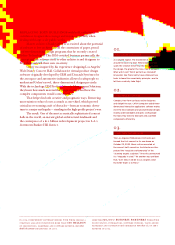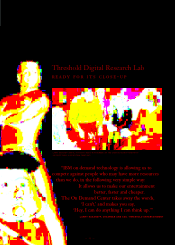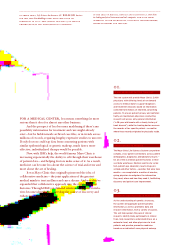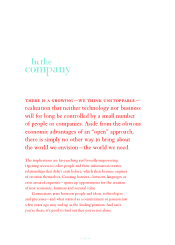IBM 2003 Annual Report Download - page 31
Download and view the complete annual report
Please find page 31 of the 2003 IBM annual report below. You can navigate through the pages in the report by either clicking on the pages listed below, or by using the keyword search tool below to find specific information within the annual report.
in three years, Life Sciences has become a $1 billion business
for ibm, more than doubling revenue each year since its
formation in 2000. new clients include 25 of the top
pharmaceutical and biotechnology companies.
in the area of medical devices and diagnostics, more than
60 leading analytical instrument and tools companies now base their
offerings on ibm technology, including ibm middleware,
server platforms and services.
01.
2,400 HEADS ARE BETTER THAN ONE
The new system will provide Mayo Clinic’s 2,400
physicians with differing levels of on demand
access to medical data to support diagnoses
and treatment decisions based on information
collected from millions of informed, consenting
patients. To ensure patient privacy and confiden-
tiality are maintained, physicians conducting
research will access only general information
(“a 38-year-old female with a family history of
heart disease”), while the treating doctor accesses
the records of her specific patient—no matter
where those records originated or physically reside.
02.
FROM MONTHS TO MINUTES
The Mayo Clinic Life Sciences System can perform
complex, cross-patient correlations across patient
demographics, diagnostics and laboratory results—
for all of the 4.4 million patient histories in their
vast data warehouse. Medical searches by symp-
tom, patient age, laboratory result, drugs pre-
scribed and other factors—searches that once took
months—are completed in a matter of minutes,
giving physician investigators the information
they need, where and how they need it, facilitating
discovery and patient care improvement.
03.
CHANGING HOW MEDICINE IS PRACTICED
As the understanding of genetics increases,
the system will aggregate patient genomic
information, as well as proteomic data and
research information, from a variety of sources.
This will help quicken the pace of clinical
research, identify likely participants in clinical
trials, help researchers understand illness on a
molecular level, and allow physicians to treat
patients and practice preventive medicine
based on an individual’s own physical makeup.
for a medical center, loss means something far more
serious than it does for almost any other business.
And the prospect of loss becomes maddening if there’s any
possibility information for treatment and cure might already
exist—but be hidden inside archived case files, or in trends across
millions of records, requiring lengthy, expensive studies to uncover.
If only doctors could tap data from consenting patients with
similar epidemiological or genetic makeup, much faster, more
effective, individualized therapy would be possible.
Now, with IBM’s help, the world-famous Mayo Clinic is
increasing exponentially the ability to sift through their warehouse
of patient data—and helping doctors make sense of it. As a result,
medicine can become less about the science of trial-and-error and
more about the art of healing.
It was Mayo Clinic that originally pioneered the idea of
collaborative medicine—the joint application of the greatest
medical minds to treat an illness and cure a disease. And now they’ve
expanded that collaborative approach into the realm of patient
histories. Through IBM’s on demand solution, trends and correla-
tives become identifiable—speeding the course of discovery and
enhancing patient care.
























